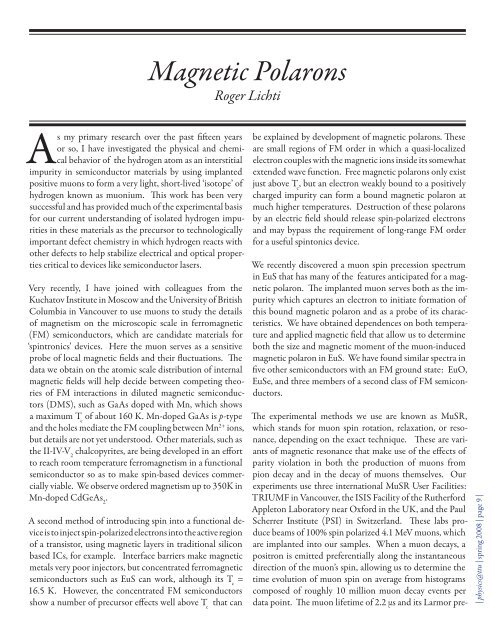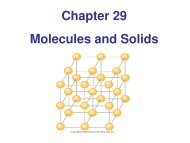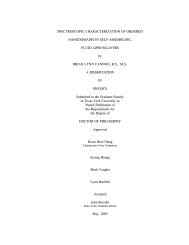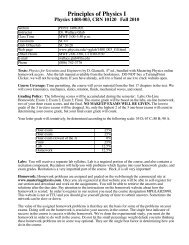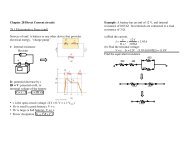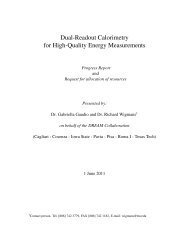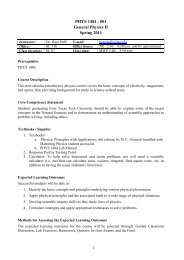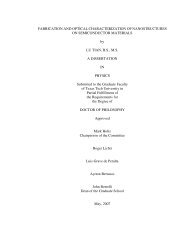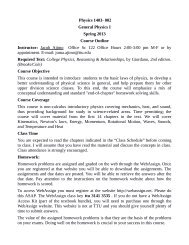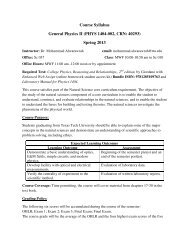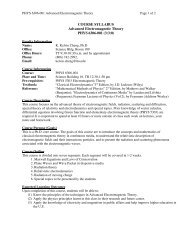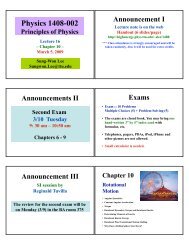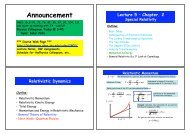Spring 2008 - Department of Physics - Texas Tech University
Spring 2008 - Department of Physics - Texas Tech University
Spring 2008 - Department of Physics - Texas Tech University
Create successful ePaper yourself
Turn your PDF publications into a flip-book with our unique Google optimized e-Paper software.
Magnetic PolaronsRoger LichtiAs my primary research over the past fifteen yearsor so, I have investigated the physical and chemicalbehavior <strong>of</strong> the hydrogen atom as an interstitialimpurity in semiconductor materials by using implantedpositive muons to form a very light, short-lived ‘isotope’ <strong>of</strong>hydrogen known as muonium. This work has been verysuccessful and has provided much <strong>of</strong> the experimental basisfor our current understanding <strong>of</strong> isolated hydrogen impuritiesin these materials as the precursor to technologicallyimportant defect chemistry in which hydrogen reacts withother defects to help stabilize electrical and optical propertiescritical to devices like semiconductor lasers.Very recently, I have joined with colleagues from theKuchatov Institute in Moscow and the <strong>University</strong> <strong>of</strong> BritishColumbia in Vancouver to use muons to study the details<strong>of</strong> magnetism on the microscopic scale in ferromagnetic(FM) semiconductors, which are candidate materials for‘spintronics’ devices. Here the muon serves as a sensitiveprobe <strong>of</strong> local magnetic fields and their fluctuations. Thedata we obtain on the atomic scale distribution <strong>of</strong> internalmagnetic fields will help decide between competing theories<strong>of</strong> FM interactions in diluted magnetic semiconductors(DMS), such as GaAs doped with Mn, which showsa maximum T c<strong>of</strong> about 160 K. Mn-doped GaAs is p-typeand the holes mediate the FM coupling between Mn 2+ ions,but details are not yet understood. Other materials, such asthe II-IV-V 2chalcopyrites, are being developed in an effortto reach room temperature ferromagnetism in a functionalsemiconductor so as to make spin-based devices commerciallyviable. We observe ordered magnetism up to 350K inMn-doped CdGeAs 2.A second method <strong>of</strong> introducing spin into a functional deviceis to inject spin-polarized electrons into the active region<strong>of</strong> a transistor, using magnetic layers in traditional siliconbased ICs, for example. Interface barriers make magneticmetals very poor injectors, but concentrated ferromagneticsemiconductors such as EuS can work, although its T c=16.5 K. However, the concentrated FM semiconductorsshow a number <strong>of</strong> precursor effects well above T cthat canbe explained by development <strong>of</strong> magnetic polarons. Theseare small regions <strong>of</strong> FM order in which a quasi-localizedelectron couples with the magnetic ions inside its somewhatextended wave function. Free magnetic polarons only existjust above T c, but an electron weakly bound to a positivelycharged impurity can form a bound magnetic polaron atmuch higher temperatures. Destruction <strong>of</strong> these polaronsby an electric field should release spin-polarized electronsand may bypass the requirement <strong>of</strong> long-range FM orderfor a useful spintonics device.We recently discovered a muon spin precession spectrumin EuS that has many <strong>of</strong> the features anticipated for a magneticpolaron. The implanted muon serves both as the impuritywhich captures an electron to initiate formation <strong>of</strong>this bound magnetic polaron and as a probe <strong>of</strong> its characteristics.We have obtained dependences on both temperatureand applied magnetic field that allow us to determineboth the size and magnetic moment <strong>of</strong> the muon-inducedmagnetic polaron in EuS. We have found similar spectra infive other semiconductors with an FM ground state: EuO,EuSe, and three members <strong>of</strong> a second class <strong>of</strong> FM semiconductors.The experimental methods we use are known as MuSR,which stands for muon spin rotation, relaxation, or resonance,depending on the exact technique. These are variants<strong>of</strong> magnetic resonance that make use <strong>of</strong> the effects <strong>of</strong>parity violation in both the production <strong>of</strong> muons frompion decay and in the decay <strong>of</strong> muons themselves. Ourexperiments use three international MuSR User Facilities:TRIUMF in Vancouver, the ISIS Facility <strong>of</strong> the RutherfordAppleton Laboratory near Oxford in the UK, and the PaulScherrer Institute (PSI) in Switzerland. These labs producebeams <strong>of</strong> 100% spin polarized 4.1 MeV muons, whichare implanted into our samples. When a muon decays, apositron is emitted preferentially along the instantaneousdirection <strong>of</strong> the muon’s spin, allowing us to determine thetime evolution <strong>of</strong> muon spin on average from histogramscomposed <strong>of</strong> roughly 10 million muon decay events perdata point. The muon lifetime <strong>of</strong> 2.2 μs and its Larmor pre-| physics@ttu | spring <strong>2008</strong> | page 9 |


